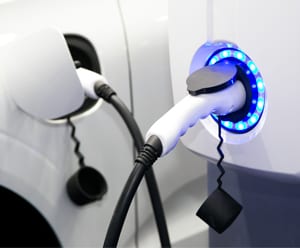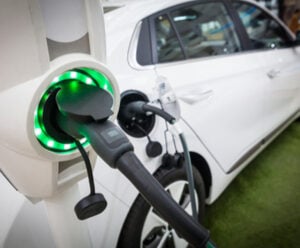
Safety first: Shipping lithium-ion batteries by air

Fully charged: the growing demand for lithium-ion batteries
Global demand for lithium-ion battery technology has skyrocketed in recent years, with forecasts predicting 18 percent annual growth in the years to come. This will be driven largely by the transformational electrification of our transportation sector – above all through electric vehicles (EVs). Realistic projections show EVs making up more than 50 percent of new car sales by 2040, and advances in EV science may well see this happen sooner.
The unrelenting consumer demand has pushed manufacturers to engineer lithium-ion batteries in ever greater density. As a result, today’s batteries offer an unbeatable combination of performance, lightweight, and efficiency. But this energy density also heightens the risks if the batteries are not transported properly. The airline industry, in particular, is concerned about the lack of awareness of the potential danger posed by lithium-ion batteries and increasing incidents of intentionally mis-declared or non-compliant lithium batteries in cargo shipments.
Transformative technology
Transformative technology
Lithium-ion battery technology entered public consciousness in the early 1990s, enabling a new generation of portable, rechargeable electronics like laptops and camcorders. Their importance grew by magnitudes with the advent of the smartphone in the early 2000s. Today, they power nearly all the gadgets that define our daily lives, from earbuds to e-scooters. Lithium-ion battery technology is so fundamental to our modern society that its inventors were awarded the Nobel Prize in Chemistry in 2019.
Surging global demand for lithium-ion batteries
Source: Statista, January 2023
Is shipping lithium-ion batteries hazardous? It depends …
Officially, yes: Lithium-ion batteries are governed under the United Nations regulations UN3480 and UN3481 as Class 9 “miscellaneous dangerous goods.” Two dangers stand out: First, improperly packaged lithium-ion batteries can lead to short circuits if they come into contact with each other or with other conductive surfaces. Second, thermal runaway can occur if improperly packaged or secured lithium-ion batteries suffer damage to their internal circuitry when shaken or dropped. Either of these situations can end in fire or explosion.
Unfortunately, most people are unaware that lithium-ion batteries are hazardous and cannot be shipped like other goods. This awareness gap, coupled with the complexity and inadequacy of current regulations, has fueled the widespread and growing noncompliance that is of such concern to the airline industry.
But there is good news: Lithium-ion batteries can be shipped safely by air if shippers take proper precautions. As with all hazardous goods, safely shipping lithium-ion batteries by air requires having personnel with the appropriate expertise and training and complying with strict labeling and packaging requirements. That is why the International Air Transport Association (IATA) is promoting the increased viability of air transport for lithium-ion batteries through a four-part approach:
- Generate awareness of the potential risk and applicable regulations.
- Promote the development of outcome-based, harmonized safety-related screening standards and processes for lithium batteries.
- Advocate for stricter enforcement mechanisms, including stiffer penalties for rogue shippers and the criminalization of egregious or willful offenses.
- Institute protections against accidents, such as fire-resistant aircraft containers.
Li-ion and EV revolution by the numbers
Li-ion and EV revolution by the numbers
18 percent
EXPECTED ANNUAL GROWTH IN GLOBAL DEMAND FOR LITHIUM-ION BATTERIES BETWEEN 2023 AND 2030
2,035 GIGAWATT-HOURS
PROJECTED ANNUAL GLOBAL DEMAND FOR LITHIUM-ION BATTERY CAPACITY IN 2030
86 percent
SHARE OF THE GLOBAL DEMAND FOR LITHIUM-ION BATTERIES IS EXPECTED TO COME FROM THE TRANSPORTATION SECTOR IN 2030
50 percent
PROJECTED SHARE OF EVS AMONG NEW CAR SALES IN 2040
Up and away: how to ship lithium-ion batteries by air
As mentioned above, transporting lithium-ion batteries is regulated by UN3480 (for batteries “contained in or packed with the equipment, but not attached to the source”) and UN3481 (“contained in or packed with the equipment, installed/integrated at the source”). There are also IATA regulations for air transport. Shippers must follow these rules, be appropriately certified, and have the training and expertise to prepare lithium-ion batteries for safe air transport.
Here are some of the criteria for shipping lithium-ion batteries by air:
State of charge
Lithium-ion batteries in transit may not exceed a defined maximum state of charge (SoC) – their level of charge relative to capacity. According to the IATA, the SoC must not exceed 30 percent, and it is the shipper’s responsibility to ensure compliance with this regulation.
Packaging
Lithium-ion batteries shipped alone must be packaged in isolation from one another and other conductive surfaces to avoid short circuits. They must also be isolated from certain other dangerous goods. Their packaging must prevent undue movement in transit and damage if dropped to protect against thermal runaway.
Labeling
Lithium-ion batteries must be appropriately labeled so everyone handling them can comply with the relevant guidelines for Class 9 dangerous goods. The required information on the label may include the type, weight, dimensions, and capacity of the battery, along with the mode of transport.
Liability
Ultimately, shippers are solely and entirely responsible for compliance and legally liable in the event of accidents due to non-compliance, so it is in their own self-interest to familiarize themselves with the UN and IATA requirements.
IATA CEIV Li-batt: the symbol of operational excellence
The Center of Excellence for Independent Validators Lithium Batteries (CEIV Li-batt) is a certification program spearheaded in part by IATA to address safety concerns and help shippers, freight forwarders, cargo handling facilities, and airlines comply with the applicable transport regulations. This compliance is documented by CEIV Li-batt certification.
Applicants must pass a CEIV Li-batt training, followed by an assessment and validation conducted by an Independent Validator to determine compliance with the criteria of the CEIV Li-batt audit checklist. Recertification is required every two years.
DHL Global Forwarding is the first CEIV Li-batt-certified organization in the United Kingdom. The certification covers six sites – Birmingham, Glasgow, London, Luton, Manchester, and Purfleet – and follows a rigorous months-long certification process across these locations encompassing employee training, on-site assessments, and audits.
Certified excellence, simply delivered
Lithium-ion battery supply chains must avoid the kinds of problems facing semiconductor supply chains. This means:
- All modes of transport must be made viable. CEIV Li-batt certification addresses the airlines’ concerns by meeting IATA’s own regulations.
- Specialized expertise is vital. At DHL, we are committed to acquiring and maintaining the expertise needed to make air transport of lithium-ion batteries safe and reliable.
The CEIV Li-batt certification confirms our compliance with safe packing, handling, and shipment of lithium batteries by air while complementing our earlier qualifications for the shipment of dangerous goods by road and rail. It also demonstrates our operational excellence, so we are auditing and certifying other key facilities in our global air freight network.
This story was first published on DHL Delivered and was republished with permission.
ALSO WORTH READING













 English
English